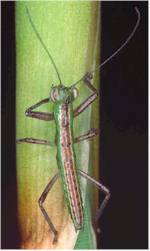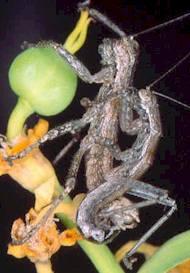Entomologists amazed by new insect order
from Namaqualand
Helen Theron
 The recent recognition of a new order of insects,
Mantophasmatodea, has been dubbed as "one of the most exciting"
recent discoveries in Zoology, boosting the total number of insect orders
(e.g. the beetles, flies, fleas, etc) to 30. The recent recognition of a new order of insects,
Mantophasmatodea, has been dubbed as "one of the most exciting"
recent discoveries in Zoology, boosting the total number of insect orders
(e.g. the beetles, flies, fleas, etc) to 30.
The formal description by entomologists of the fairly large, wingless
creatures, which to the untrained eye resembles a cross between a
grasshopper and a praying mantis, is the first description of an insect
order since the discovery of ice crawlers (Grylloblattodea) in
1914, almost a century ago.
Small and bandy-legged, the wingless insects from the new order are
aggressive carnivores, leaping on their prey and subduing them with their
spiny legs. They walk on their heels, and are grey, brown or bright green
in colour. The female is bigger than the male and often eats him after a
prolonged and uninterrupted copulation of about three days. The female
lays a series of up to 10 egg pods in the sand, each containing about 12
eggs, which hatch and develop during the wet winter months: adults appear
in spring and die after about one month. The new order has no common name
as yet.
Though scientists have found the insects embedded in Baltic amber,
suggesting that they existed around 40 to 50 million years ago in Europe,
the new order appears to be restricted to southern Africa in present
times.
 German insect anatomist Dr Klaus Klass and researchers
Oliver Zompro, Prof Niels Kristensen and Prof Joachim Adis, described the
new order in Science magazine (24 May, 2002, Volume 296, pp 1456-1459),
based, on just two museum specimens from Tanzania and Namibia. German insect anatomist Dr Klaus Klass and researchers
Oliver Zompro, Prof Niels Kristensen and Prof Joachim Adis, described the
new order in Science magazine (24 May, 2002, Volume 296, pp 1456-1459),
based, on just two museum specimens from Tanzania and Namibia.
Dr Eugene Marais (Windhoek Museum, Namibia) then alerted these
entomologists to a similar specimen in his collection, and in February
this year led an expedition to Namibia's Brandberg, discovering one of the
specimens described in the Science paper, plus another spiny species
(dubbed the "gladiator").
The article caught the attention of University of Cape Town
entomologist Dr Mike Picker. Though it referred to the Namibian and
Tanzanian specimens, Picker realised he and his students had frequently
encountered the insects in South Africa.
Picker wrote to Science reporting that he and students Jonathan
Colville, Anthony Roberts and Mark Kirkman had previously noted the
unusual orthopteriod insects in the semi-arid regions of the succulent
Karoo (Namaqualand). "It emerged that we hadn't realised the evolutionary
significance of the creatures we'd photographed in Namaqualand!" he added.
He recovered 29 additional pinned specimens in South African museums,
collected from 1890 to 1994. "Specimens from museum and field collections
are currently known from about 30 localities, some of which are 600 km
apart; and appear to represent at least four species," Picker
reported.
After Picker's letter appeared, Klass contacted him, and
they subsequently established a collaboration, the South African
Mantophasmatodea Project, which brings together researchers from Japan,
Germany, Denmark, the US and Namibia. (The Project also involves
collaboration with the Iziko Museums of South Africa and the ARC-Plant
Protection Research Institute in Pretoria.)
The team will study, among other aspects of the biology of the group,
the relationship between the South African species and the Namibian
species. Only a single family, Mantophasmatidae, is currently
recognised. Three species have so far been identified in Namibia and at
least four in South Africa.
Set against a universal scenario of shrinking biodiversity coupled with
the increasing extinction rates, the find of a new group of animals so
fundamentally different from all other insects groups both surprised and
excited biologists, who had assumed that most major animal discoveries had
already been made. The apparent centre of distribution of the group in the
Succulent Karoo of South Africa adds yet another biological jewel to the
already impressive concentration of endemic plants and insects of this
region.
In UCT's Zoology Department, the numerous cultures that daily consume
vast quantities of drozzies (small vinegar flies) will hopefully provide
answers to some fundamental questions, such as the evolutionary
relationship of the Mantophasmatodea to the existing insect
orders.
Photos by Dr Mike Picker.
| 

